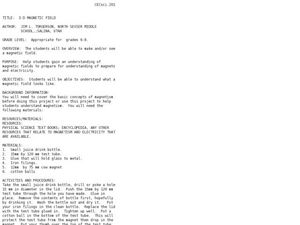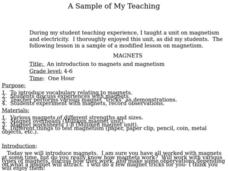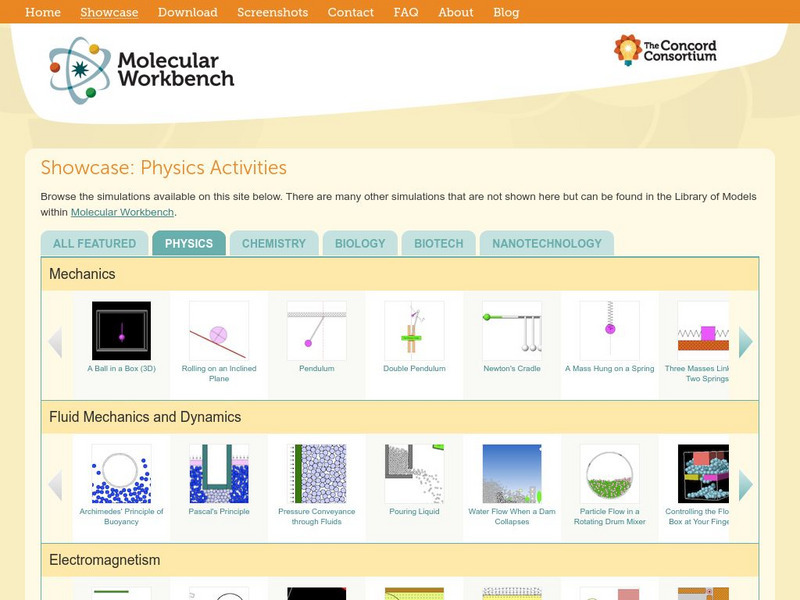Curated OER
Exploring Magnetism and Electricity
Students explore Faraday's Law. In this electromagnetism activity, students investigate Michael Faraday. Students discover the history of the electromagnet. Students examine the parts of an electromagnet.
Curated OER
Magnetometer Extension Activities
Students observe magnetic fields and locate the position of "ore deposits" patterns using models and maps. For this magnetometer lesson students complete a hands on activity and a reading/writing exercise.
Curated OER
3-D Magnetic Field
Middle schoolers create a magnetic field. In this investigative lesson students design their own magnetic field so that they can see how magnetism and electricity work.
Curated OER
Discovery Science Center Activities
Fourth graders complete a variety of experiments to meet science goals. In this life sciences lesson, 4th graders make yogurt, discover the attraction of opposite charges in electricity, learn the effects of glaciers, and explore...
Curated OER
Magnetic Fields
In this magnetic field worksheet, students test a compass's magnetic field against a magnet and see how far it lasts. Students follow 6 sets of directions.
Curated OER
What is Magnetism?
For this magnetism worksheet, students review what magnetism is by matching 5 words to their definitions. Then students use a diagram showing the pattern of iron fillings around magnets to complete 4 short answer questions.
Curated OER
Magnetism
In this magnetism worksheet, students review concepts relating to magnetic fields, transformers, galvanometers, and electric motors. This worksheet has 9 fill in the blank and 11 short answer questions.
Curated OER
Through Which Materials Do Magnets Work?
In this magnets activity, students will experiment to see what materials attract or repel from magnets. Students will fill in the blank of 3 statements.
Curated OER
Cells: The Units of Life
In this biology worksheet on cells, 9th graders name who the first person was to use the word cell and describe in what materials this person saw cells. Then they determine what instrument uses light and two or more lenses to view cells.
Curated OER
MAGNETS
Students identify magnetism and describe its meaning. Students discuss different types of magnets and list various ways magnets can be used. Students record observations of each magnet, like and different, and whether one has a larger...
Curated OER
Going My Way?
Students, in groups, study how a magnet works and how people use the Earth's magnetic field to orient themselves.
Curated OER
Making a Magnet / Compass
Fifth graders explore the components of a compass and how it is utilized to determine geographical directions. The magnetic field of Earth and the magnet used to magnetize the needle used in the experiment are compared and contrasted in...
Curated OER
MAP MAGNETIC FIELD OF A ROOM
Young scholars map the magnetic field of a room (classroom or room at home -- recommend kitchen) at two or more heights. They create a coordinate grid within the room and make a relatively accurate map of the room to super impose the...
Curated OER
Exploring Magnetic Fields
Students develop the concept that magnets attract and repel items and exert a magnetic field that can vary in strength.
Curated OER
The Magnetic Field in a Current Carrying Coil
Students explore the relationship between a current in a coil and the magnetic field. In this physics lesson students complete a lab activity using a magnet and batteries.
Curated OER
Invisible Investigations
Students simulate how charged particles move in a particle detector. In this physics lesson, students observe how iron filings behave when magnetic marbles are passed underneath them. They record and draw their observations.
Curated OER
How to Be "Naturally Attractive" (Without Even Trying)
Students examine the various properties of magnets, explain how a compass works and make an electromagnet. They also experiment with magnetic lines-of-force using paper and iron filings.
Curated OER
Exploring Magnetism
Twelfth graders experiment with magnets in order to visualize that magnets have a north and south pole, some materials can be magnetized, and magnetization occurs because of the magnetic moments of individual molecules in matter.
Curated OER
Map Field of Current
Students determine that moving charges create a magnetic field. They discover that the speed and direction of motion, the amount of charge, and the deflection angle observed are closely linked. A voltmeter, pendulum, and a constructed...
Concord Consortium
Concord Consortium: Molecular Workbench Showcase: Physics, Electromagnetism
Students can use these simulations to understand concepts in electromagnetism. Simulations are available on the following concepts: Lorentz Force, The Hall Effect, capacitor, conductor, transistor, cyclotron, static electricity....
NOAA
Noaa: Make Your Own Compass [Pdf]
Build a compass to help you figure out which direction is north or south.
Massachusetts Institute of Technology
Mit: Open Course Ware: Courses: Physics Ii: Electricity and Magnetism
College-level physics course highlighting electricity and magnetism. This course is divided into several modules including electric fields, magnetic fields, electromagnetic forces, conductors and dielectrics, electromagnetic waves, and...
University of Colorado
University of Colorado: Ph Et Interactive Simulations: Faraday's Electromagnetic Lab
This interactive lab in electromagnetics effectively illustrates how Faraday's law works.
University of Colorado
University of Colorado: Ph Et Interactive Simulations: Generator
Generate electricity with a bar magnet! Discover the physics behind the phenomena by exploring magnets and how you can use them to make a bulb light. Java required.






















![Noaa: Make Your Own Compass [Pdf] Activity Noaa: Make Your Own Compass [Pdf] Activity](https://d15y2dacu3jp90.cloudfront.net/images/attachment_defaults/resource/large/FPO-knovation.png)

